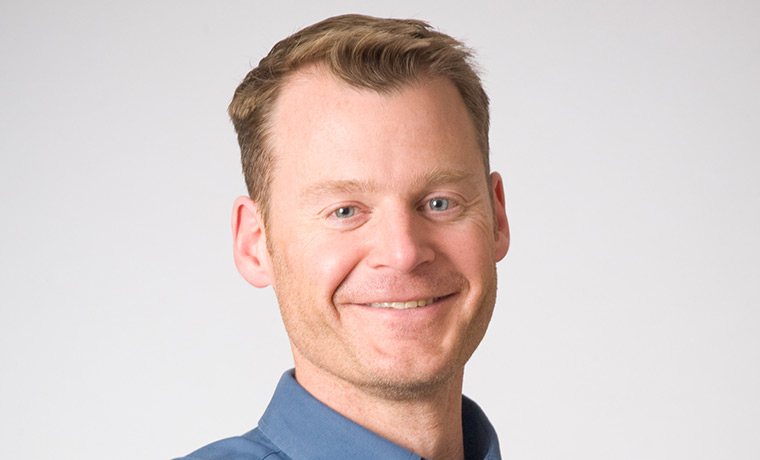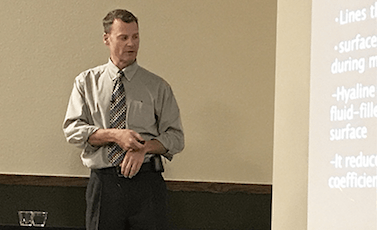Dr. Repine on Hip & Knee Arthritis: 'No Reason to Put Up with the Pain Anymore.'
- Category: General, Orthopedics, Surgery
- Posted On:
- Written By: Boulder Community Health

When osteoarthritis strikes a hip or knee, the pain can become so unbearable that it can make even walking difficult, threatening to end an active lifestyle. In the past, it wasn’t uncommon for sufferers to accept a sedentary life when the pain set in.
“But now, there are a number of excellent non-surgical and surgical treatment options. There is no reason to put up with the pain and dysfunction anymore,” orthopedic surgeon Michael Repine, MD, of Boulder Medical Center said during a free health lecture.
“When daily activities are compromised, when quality of life is diminished, intervene. Do not wait!”
What is Osteoarthritis?
Dr. Repine started the lecture by reviewing the basics of osteoarthritis. He said it occurs when cartilage — a smooth, slippery substance that lines the ends of bones and cushions a joint — wears away.
“Healthy, normal cartilage allows the ends of bones to roll and slide easily against each other during motion. But too much wear on the cartilage’s surface leads to its deterioration, similar to how tread on the tires of a car wears down over time,” Dr. Repine said. “When the cartilage becomes thinned or absent, the bones rub together, causing pain and limited function.”
Symptoms of Knee and Hip Osteoarthritis
According to Dr. Repine, symptoms of osteoarthritis tend to build over time rather than show up suddenly. Here are ways it can affect hips and knees:
Knees
PAIN
- During weight-bearing activities
- While sleeping at night
- Located across entire knee or focally to an area
INFLAMMATION
- Warmth in the joint
- Swelling or stiffness, which can be more pronounced after a period of inactivity
LIMITED MOTION, GRINDING AND POPPING
- Loss of flexibility or restricted range of motion in the joint
- Overall weakness, causing the knee to give way or buckle
- Creaking, crackly or popping sounds during movement
Hips
PAIN
- In the groin area, buttocks or on the outside of your hip
- Sometimes on the inside of the knee or thigh
- During weight-bearing activities
- While sleeping at night
- With rainy weather
STIFFNESS
- In the hip joint
- As you are getting out of bed
- After you sit for a long time
LIMITED MOTION AND CRUNCHING
- Locking" or "sticking" of the joint
- A sound or feeling ("crunching") of bone rubbing against bone
 Non-Surgical Treatment Options for Arthritis
Non-Surgical Treatment Options for Arthritis
Early treatment of osteoarthritis is nonsurgical. Dr. Repine reviewed the range of treatment options.
Physical therapy
“Physical therapy is almost always the first step in treatment. The goal of physical therapy is to reduce pain and improve range of motion and strength,” Dr. Repine stated.
He then went over the pros and cons of other options.
Nonsteroidal anti-inflammatory drugs (NSAIDs)
- Pros: Decreases inflammation and pain.
- Cons: When used long term, there is a risk of gastrointestinal bleeding.
Nutritional supplements
- Pros: Many sufferers find nutritional supplements helpful such as glucosamine and chondroitin.
- Cons: Too many of these products don’t measure up to their claims and data on proven effectiveness is somewhat inconsistent. None have passed FDA testing to prove effectiveness.
“Since there are thousands of supplements on the market, conduct your own personal trial study. Take a supplement for a little while to see whether it works or not," said Dr. Repine.
Cortisone injection
- Pros: Relatively well-tolerated procedure done under fluoroscopy that offers "a very predictable reduction in pain." Dr. Repine stated that it often “buys time” for patients whose joint isn’t quite ready for total replacement.
- Cons: The injection must be placed carefully and can soften the cartilage with repetitive use, potentially weakening the joint. Also, it tends to mask symptoms without addressing the actual cause.
Viscosupplement injection (hyaluronic acid)
- Pros: Protects any remaining cartilage and helps improve the biochemical environment of the joint, offering reliable reduction in pain.
- Cons: Currently, approved for knees only but is being studied in other joints. Also, there’s a small potential for a reaction with repetitive administration.
Stem cell therapy (pain-relieving injection)
- Pros: Anecdotal reports appear promising when osteoarthritis is caught early.
- Cons: It's expensive and its uses are still being heavily researched.
“This will likely be the best future option for moderate arthritis,” according to Dr. Repine.
Clarix Flo
- Pros: A regenerative therapy that promotes tissue growth and healing, decreasing pain.
- Cons: It's efficacy remains to be proven.
Dr. Repine explained, “Clarix Flo is an injection containing umbilical cord tissue and amniotic membrane from human placenta. It’s rich in growth factors, which basically encourages your body to repair damaged tissue from the degenerative process and control inflammation.”
Cannabidiol (CBD) oil
- Pros: Naturally occurring extract from hemp (extracts from cannabis plants). Available in capsules or oils and salves, which you can easily apply to the skin of the areas affected by osteoarthritis.
- Cons: To date, there is a lack of scientific evidence proving conclusively that CBD oil is an effective arthritis treatment.
“While new studies have been encouraging, more research is necessary to verify that CBD oil is an effective treatment for osteoarthritis inflammation and pain,” Dr. Repine said.
Surgical Treatment Options
Still, even after taking these steps, many people with knee or hip osteoarthritis look to surgery as a way to get relief from bone-on-bone pain and resume the physical activities they enjoy.
Hip Arthritis
Moderate hip osteoarthritis can often be treated arthroscopically and sometimes with cartilage transplantation.
“But when arthritis becomes advanced, hip replacement is the best option for pain relief and restoring function,” Dr. Repine advised. “Because hip replacement is predictably so good in restoring function and pain relief, the choice is really replacement when appropriate.”
Dr. Repine uses the front-of-the-hip (anterior) approach to hip replacement rather than traditional surgery, which requires cutting through muscles at the back of the hip, leaving patients with a long recovery. With the anterior approach, he accesses the hip joint by making an incision at the front of the hip, near the groin, and gently pushes muscles aside rather than cutting them. This leads to a quicker, less painful recovery.
"One other important benefit of the anterior approach is the very low risk of hip implant dislocation," he added. “Combining the anterior approach with computer-assisted Mako technology – which uses a state-of-the-art robotic arm and computer-guided mapping software to ensure precise positioning– maximizes outcomes,” said Dr. Repine.
Knee Arthritis
Knee osteoarthritis located in a well-defined area is most often treated arthroscopically. Sometimes cartilage transplantation or resurfacing can also be an option. “For these surgical treatments to be effective, we must catch the damage early on, before any secondary bone changes occur,” according to Dr. Repine.
More advanced arthritis often requires more advanced surgical options, including Mako robotic-arm assisted surgery for partial knee resurfacing and total knee replacement. However, Dr. Repine warned that you shouldn't wait too long to consider surgery because "you can miss the boat for certain procedures.”
He then went on to explain how BCH's computer-assisted Mako technology uses a state-of-the-art robotic arm with computer-guided mapping software. Mako syncs a patient’s preoperative CT scan data to intraoperative data, providing each patient with a personalized surgical plan based on their unique anatomy. This allows for the highly accurate placement and alignment of a knee implant.
BCH’s Foothills Hospital was the first facility in Colorado to offer Mako Total Knee Replacement.
“It is a real game changer,” Dr. Repine said, “Mako Total Knee Replacement is the latest and greatest for total knee replacement. It can offer the potential for a shorter recovery time and more natural feeling knee for knee replacement patients.”
If you suffer from symptoms of osteoarthritis, schedule an appointment with Michael Repine, MD, by calling 303-440-3036.
Click here to view PowerPoint slides from Dr. Repine’s lecture on “Innovative Treatments for Knee and Hip Arthritis.”
Want to receive notification of special events and lectures? Sign up to receive email notifications.